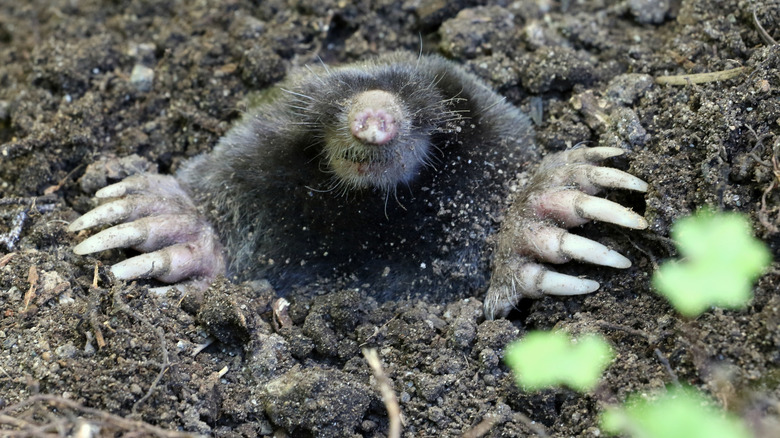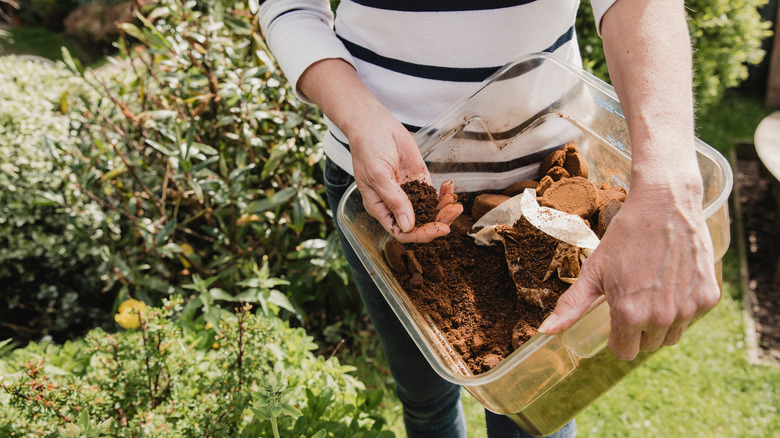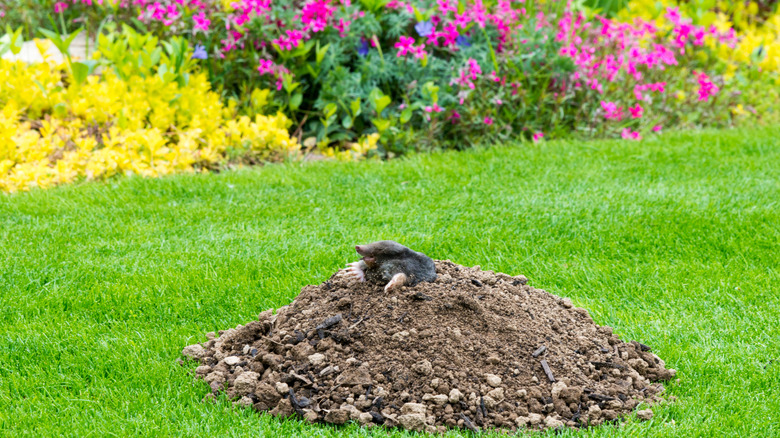Garden Moles Don't Stand A Chance Against This Kitchen Staple
There is nothing more relaxing than sitting on your front porch sipping a cup of coffee just as the sun rises. You might be mesmerized by the sherbet-colored sky until you look down and notice mounds of dirt, like mini volcanoes scattered around your yard ... Molehills. Fortunately, there is a way to evict the tunneling pests without having to unleash traps or pull out poison. The solution is surprisingly easy and organic. Garden moles don't stand a chance against the very same kitchen staple you use to fuel your morning routine: coffee grounds.
They may resemble dirt-covered footballs, but molehills are far from fun. The unsightly markings are the calling cards of furry mammals who invade yards looking for food such as earthworms, grubs, and insect larvae. As moles hunt for dinner, they plow through plant root systems and rip up turf which can kill seedlings, expose bulbs, and destroy grass. What's more, if left untreated the expert diggers are capable of creating 150 feet of new tunnels in your lawn or garden each day, and your plumbing can suffer. Blemishes you see on the surface of your landscaping pales in comparison to the widespread damage the burrowing critters inflict underground.
Getting rid of moles in your yard or garden requires a strategy, but removal doesn't have to be expensive or time consuming. It turns out moles despise the smell of coffee and will venture elsewhere if it is placed near their living spaces.
How to use coffee grounds as a mole deterrent
Deodorizing smelly shoes, repairing scratches on wood furniture, and cleaning fireplaces are some of the unexpected uses for leftover coffee grounds around your home. If you have a mole problem, you can harness the power of those java remnants here too. One of the easiest ways is to simply brew your joe per usual, place the grounds in a container, and transport them to your yard. Next, liberally sprinkle the damp dregs around mole holes or scoop them in the openings of molehills, then cover with fresh soil. For an added line of defense, you can combine used coffee grounds and water in a bucket, mix thoroughly, and pour around the perimeter of your yard to create a border of sorts that will ward off pesky moles.
Another option is to use fresh coffee grounds — either grind your own from whole beans or use the pre-ground variety. Heap generous amounts of the coffee in and around areas where moles have infiltrated your property. Additionally, you can scatter caffeinated or decaffeinated grounds in thick lines on garden beds or grassy areas where you have witnessed mole activity. While coffee's pungent odor repulses moles, in order for the natural deterrent to sustain its effectiveness, fresh or newer used grounds must be reapplied to the affected areas daily until the moles are gone. Then you can reduce the treatment to once every two weeks to prevent the subterranean vermin from returning.
Tips to consider before using coffee grounds to banish moles from your yard
Moles need sufficient exposure to coffee's bitter fragrance in order for it to drive them away from your garden. Consequently, you may have to trim shrubs or remove weeds to properly identify all points of entry to maximize the scent's effectiveness. Moreover, it pays to be steadfast with your approach as missed spots will leave your yard vulnerable to future mole attacks.
In addition, when using coffee grounds to keep moles out of your yard, keep an eye on the weather. Heavy rain can dilute coffee grounds and reduce their scent. To maintain a strong coffee smell, simply toss leftover grounds in your garden each day after brewing your morning blend. Since coffee grounds contain nutrients that plants use for growth, you don't have to be concerned about adding them to your soil. Just be careful not to dump caffeinated remnants on seedlings or immature plants as doing so can compromise their development. In addition, if you are worried about coffee grounds increasing soil acidity, treat mole holes and hills with used grounds, which are only slightly acidic, rather than fresh grounds which tend to have a higher acid content.
Finally, moles are deep diggers. Their passageways typically measure at least 10 inches underground. Additionally, they don't usually come to the surface unless they are searching for a mate. As such, trying to time your coffee ground treatment to coincide with their appearance is unwise.


